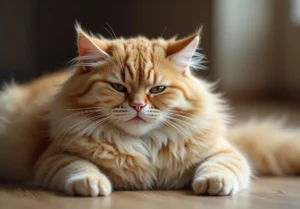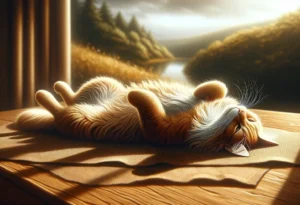Have you ever noticed that your cat seems to never stay still when you pet her? It can be frustrating when your furry friend constantly moves around, making it difficult to give her some pets and scratches. But why does she do this? Let’s explore the reasons behind this common cat behavior.
The simple answer is that your cat may be displaying signs of overstimulation. When you pet your cat, especially in certain areas like her back or belly, she may reach a point where she becomes overwhelmed with the sensation. This can lead her to move around, squirm, or even try to bite or scratch you as a way to signal that she’s had enough.
Is Petting Technique Important?
Have you ever considered that the way you pet your cat could be influencing her movements? Petting technique is crucial when it comes to how your cat responds to your touch. Cats are known for their independent nature, and they have specific preferences when it comes to how they like to be petted.
Consider starting with gentle strokes along your cat’s back and ears, paying attention to her body language. Avoid rough petting or petting against the grain of her fur, as this can cause discomfort and lead to a cat squirming or moving away. Cats have sensitive areas, so finding the right touch for your feline friend is key to a successful petting session.
Remember, each cat is unique, so experiment with different petting techniques to see what your furry companion enjoys most. By being mindful of how you pet your cat, you can create a more enjoyable and relaxing experience for both of you.
Can Cats Be Ticklish?
Have you ever wondered if cats can be ticklish? While cats don’t react to tickling in the same way humans do, they can still exhibit sensitive spots that cause them to move when petted. Just like humans, cats have areas that are more sensitive to touch than others.
When petting your cat, pay attention to how she reacts in different areas. Some cats may have a ticklish reaction to certain spots, such as their belly or the base of their tail. If your cat suddenly moves or twitches during petting, she may be experiencing a ticklish sensation.
It’s important to respect your cat’s boundaries and avoid persistent petting in sensitive areas if she shows signs of discomfort. By being aware of your cat’s potential ticklish spots, you can ensure a more pleasant petting experience for both of you.
And remember, a happy cat means a happy pet parent!
Signs of Cat Overstimulation
When your cat starts twitching her tail, flattening her ears, or even giving you a gentle nip during petting, these are all signs that she might be getting overstimulated. Some cats are more sensitive than others and can reach their petting limit faster. Pay attention to these subtle cues to avoid pushing your feline friend over the edge.
How to Help an Overstimulated Cat
If you notice your cat exhibiting signs of overstimulation during petting, give her some space and let her come to you when she’s ready for more affection. Slow down your petting to a gentle pace, focusing on areas she enjoys, like chin scratches or behind the ears. Offering treats or engaging in interactive play can also help redirect her energy and provide a positive interaction.
Tips to Help an Overstimulated Cat:
- Observe Her Body Language: Watch for signs of discomfort to prevent overstimulation.
- Limit Petting Time: Keep petting sessions short and sweet to prevent overwhelming your cat.
- Provide Safe Spaces: Give your cat a designated quiet area where she can retreat if she needs a break.
- Use Toys for Distraction: Interactive toys can help redirect your cat’s energy away from overstimulation.
For more information on cat behavior and overstimulation, check out this helpful guide from the American Association of Feline Practitioners: Understanding Your Cat’s Behavior.
Establishing Boundaries with Your Cat
When it comes to why your cat keeps moving when you pet her, it could be a sign that she is feeling overstimulated. Cats have individual preferences for physical contact, and it’s crucial to establish boundaries to ensure a positive interaction. If your cat starts moving around a lot during petting, it may be a signal that she needs a break. Pay attention to her body language – if her ears flatten, tail starts flicking, or she tries to move away, it’s time to back off and give her some space. By respecting your cat’s boundaries, you can build trust and strengthen your bond with her.
The Power of Positive Reinforcement
Ever wondered why your cat seems to squirm and wiggle away when you pet her? One effective way to encourage your cat to stay still during petting is to use positive reinforcement. Reward her with treats or praise when she remains calm and relaxed while being petted. By associating staying still with positive experiences, your cat will be more likely to adopt this behavior. Consistency is key – practice short petting sessions and gradually increase the duration as your cat becomes more comfortable. With patience and positive reinforcement, you can help your cat enjoy petting sessions without constant movement.
Key Tips for Establishing Boundaries with Your Cat: 1. Watch for signs of overstimulation such as flattened ears or tail flicking. 2. Give your cat breaks during petting sessions to avoid overwhelming her. 3. Respect your cat’s personal space and body language to maintain a positive interaction.
By setting clear boundaries and using positive reinforcement techniques, you can help your cat feel more relaxed and content during petting sessions. Understanding your cat’s individual preferences and personality will go a long way in strengthening your bond and creating a harmonious relationship.
Understanding Your Cat’s Body Language
Alright, so your cat keeps squirming around when you’re trying to show her some love? Well, let’s try to crack the code on what’s going on. Cats are mysterious creatures, but their body language can give us some clues. When you’re petting your cat, keep an eye out for signs of enjoyment like purring, kneading, or relaxed body posture. If your cat starts twitching her tail rapidly or flattening her ears, those are signs she might not be feeling the love as much as you’d hope. Pay attention to these subtle cues to make sure you’re hitting the right spot when you’re giving her a good scratch behind the ears.
Remember, just like people, cats have their own boundaries and preferences. If your cat seems fidgety or starts trying to wriggle free, it might be a sign that she’s reached her petting limit. Give her some space and respect her boundaries. Every cat is different, so take the time to get to know your furry friend’s unique cues. It’s all about building that trust and understanding with your cat, so you can both enjoy your time together to the fullest.
And hey, if you’re still not sure why your cat is doing the hokey-pokey every time you try to pet her, don’t hesitate to consult with a professional. A vet or animal behaviorist can offer valuable insights tailored to your specific situation. Remember, your cat’s comfort and happiness are top priority, so don’t be afraid to seek help if you need it.
Tips for Understanding Your Cat’s Body Language:
- Watch for signs of enjoyment like purring and relaxed body posture
- Be mindful of cues like rapid tail twitching or flattened ears indicating discomfort
- Respect your cat’s boundaries and give her space when needed
- Consult with a vet or animal behaviorist for personalized advice and guidance
For more in-depth insights on decoding your cat’s body language, check out this helpful resource from the American Society for the Prevention of Cruelty to Animals (ASPCA): Understanding Your Cat’s Body Language
Alex, a passionate animal lover, has experience in training and understanding animal behavior. As a proud pet parent to two dogs and three cats, he founded AnimalReport.net to share insights from animal experts and expand his knowledge of the animal kingdom.




